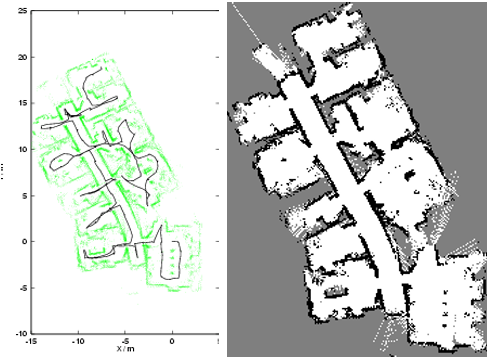




Did you find this useful? Give us your feedback



![Fig. 1. Raw sensor data from the Artificial Intelligence Lab, Freiburg, as in [6], showing the odometry trace and laser rangefinger readings.](/figures/fig-1-raw-sensor-data-from-the-artificial-intelligence-lab-nuy0b1il.png)





406 citations
176 citations
...Duckett (2003) searches through the space of possible robot trajectories using a genetic algorithm....
[...]
...topologies. Duckett (2003) searches through the space of possible robot trajectories using a genetic algorithm....
[...]
165 citations
115 citations
...In [17], a GA with a simple fitness function design was applied in mobile robot localization and mapping but insights into the algorithm were not reported either....
[...]
102 citations
...Recent work by Duckett [7] on the SLAM problem is similar to our own, in the sense that he too deals with the space of possible maps....
[...]
967 citations
...Individuals are then assigned an offspring count that is solely a function of their rank, using the scheme proposed by Baker [1]....
[...]
...REFERENCES [1] J. Baker....
[...]
836 citations
...The EKF requires analytic models of the vehicle motion and observations, it makes a number of assumptions which are often violated in practice, and it will fail whenever data association fails....
[...]
...A further possibility would be to combine the global search algorithm with a local optimization method, e.g., EKF [5], consistent pose estimation [10], relaxation [3], etc....
[...]
...The EKF is used for normal operation, only switching to the sampling technique to resolve ambiguities in landmark identification, e.g., when a large loop is to be closed....
[...]
...Nebot et al. [14] extended the EKF with a Monte Carlo sampling technique for handling possible data association errors....
[...]
..., EKF [5], consistent pose estimation [10], relaxation [3], etc....
[...]
826 citations
648 citations
...V. EXPERIMENTAL RESULTS The algorithm was first tested using data recorded by a Pioneer I mobile robot equipped with a SICK laser scanner at the Artificial Intelligence Lab of the University of Freiburg [6]....
[...]
...[8] K. Konolige and K. Chou....
[...]
...The algorithm was first tested using data recorded by a Pioneer I mobile robot equipped with a SICK laser scanner at the Artificial Intelligence Lab of the University of Freiburg [6]....
[...]
...Gutmann and Konolige [6] considered mapping of large, circular environments using a combination of topological and metric representations....
[...]
...Raw sensor data from the Artificial Intelligence Lab, Freiburg, as in [6], showing the odometry trace and laser rangefinger readings....
[...]
145 citations
...Then a global correlation procedure [8] was used to detect when a previously visited location had been reached....
[...]
A further possibility would be to combine the global search algorithm with a local optimization method, e. g., EKF [ 5 ], consistent pose estimation [ 10 ], relaxation [ 3 ], etc. A further possibility would be to investigate implementation of the algorithm on parallel processors, given the parallel nature of evolutionary computation. Future work should also include more detailed theoretical and empirical analysis of the problem and the algorithm required to solve it, e. g., with respect to the fitness criteria needed for different environments.